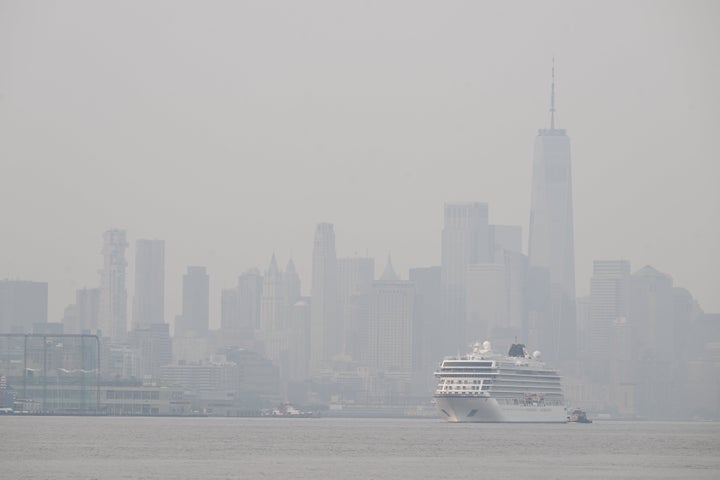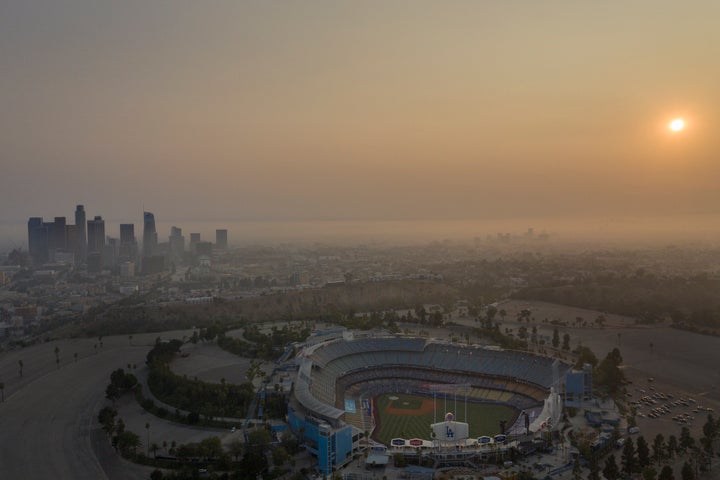
Wildfire seasons are becoming more and more devastating and damaging for everyone.
Wildfires aren’t just dangerous for the people and wildlife living directly around the flames, but also for those nearby who are exposed to heavy smoke. And because smoke can travel long distances, even people thousands of miles away from the fires can feel their effects.
Scientists are actively learning about the harms linked to wildfire smoke, but early findings suggest that wildfire smoke can have a seriously detrimental effect on our short and long-term health.
Why breathing in wildfire smoke is harmful
Wildfire smoke contains a mixture of gases, liquids and solid particles. What concerns scientists the most about wildfire smoke is the fine particulate matter (called PM 2.5), or small pieces of liquid and gas that can stay suspended in the air.
The smallest particles are the ones that can get deepest into the lungs and cause annoying symptoms — like a cough or shortness of breath — in the short term and more concerning health problems down the road, explained Colleen Reid, an environmental epidemiologist and health geographer with the University of Colorado Boulder.
According to Reid, no level of PM 2.5 is considered safe — but at higher levels, the health effects are clearly worse.
“A study from Montana found that seasons with record-high smoke were followed by more severe flu seasons, adding to the growing body of evidence that wildfire smoke can make people more susceptible to viruses and infections.”
How wildfire smoke immediately affects us
These tiny particles can get deep into our lungs and enter the bloodstream, at which point they can travel to other organs and cause widespread inflammation, Reid explained. One report found that teens living near wildfires have higher levels of inflammatory markers in their blood. Wildfire smoke can cause sore throats, a cough, watery eyes, congestion, headaches and difficulty breathing or shortness of breath. Smoke particles can also reach the brain and trigger cognitive issues.
According to Rosana Aguilera Becker, an environmental health scientist with the University of California, San Diego, people who have asthma, respiratory illnesses or COPD are most at risk and have higher rates of hospital admissions due to smoke during wildfires. In areas close to wildfires, researchers have found a spike in inhaler refills among people who have asthma.
Increases in visits to the emergency room for cardiovascular events and heart attacks have also been recorded in communities experiencing wildfires.
What we know about the long-term health effects
The effects don’t go away once the smoke clears. A study from Montana found that seasons with record-high smoke were followed by more severe flu seasons, adding to the growing body of evidence that wildfire smoke can make people more susceptible to viruses and infections.
The long-term health consequences linked to wildfire smoke exposure are understudied, largely because this hasn’t been a big issue until recently. In the past, there would be a wildfire, smoke would shoot into the sky for a short period of time, then the clogged air would clear out. It wasn’t until the past few fire seasons that the air quality has been really bad over really large geographic areas for really long periods of time, Reid said.
But there are some clues. Wildfire smoke is thought to be a risk factor for dementia and Alzheimer’s disease. And through her research, Reid has found that when pregnant people are exposed to wildfire smoke, there’s a greater risk of the baby being born early or at low birth weight.
A study conducted on monkeys found that primates exposed to wildfires as infants had worse pulmonary functioning and immune functioning later on in life. This brings up the question of “what happens to children when they’re exposed to wildfire smoke when they’re still developing,” Becker said.
Evidence looking at the long-term health effects of other types of air pollution suggests that harmful air can impact our respiratory health, cardiovascular health and neurological health. One study found that kids who grew up in areas with polluted air, like Los Angeles, go on to experience worse lung function as adults.
“We could assume, based on what we know, that there are similar things with wildfire smoke,” Reid said, noting that we really need more research on wildfire smoke specifically.

Does proximity to the wildfire matter?
Scientists know the most about smoke exposure in communities that are close to wildfires. But what happens when that air travels thousands of miles, as it did this summer when the jet stream brought Oregon’s wildfire smoke to the East Coast? According to Reid, there can definitely be health consequences in these places, too.
In the past, air pollution that traveled long distances was minuscule, but the fires in Oregon and Canada showed us that wildfire smoke can travel far and at really high concentrations. This is an area scientists will need to look into in the coming years. There may be differences in how fresh smoke and older smoke affects our health — but, again, no level of PM 2.5 is safe.
Our behaviors also play a role. When a fire erupts in the West, people are aware of the fire and know to stay in. You can smell it and you can see plumes of smoke spilling into the air. On the East Coast, where there are no plumes or traces of a campfire scent, some people may not take the necessary steps to protect themselves from inhaling bad air, Reid said.
Here’s how to protect yourself from wildfire smoke
You can gauge the quality of the air around you by checking your local air quality index (AQI). Reid recommends the app Smoke Sense, which provides an air quality map and recommendations for what you should or shouldn’t do. Air NOW is another tool that sends local alerts about AQIs.
If PM 2.5 levels are high, the best thing to do is stay inside and limit your outdoor activities, Becker said. It’s OK for most people to exercise at lower PM 2.5 levels, as the benefits of exercise are thought to outweigh the risks.
If you can afford an air purifier — they can be pricey! — get one with a HEPA filter. Keep your doors and windows closed. Older homes and rental properties tend to be leakier and allow more air pollution in. You can also purchase a MERV-13 filter and put it in a box fan or your AC unit. Make sure you’re regularly cleaning your car filters as they can collect a lot of particles over time. (You can find a list of filtering products certified by the Asthma & Allergy Foundation of America here.)
If you do venture outside when the PM 2.5 levels are high, bring a mask. N95 masks are the gold standard because they filter all of the air that you breathe in. Though surgical masks are less effective, they’re ultimately better than having no barrier between you and the harmful particles in wildfire smoke.